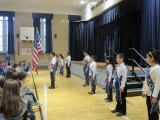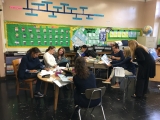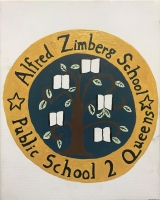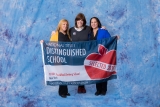-
Category 2
Selected in 2017
-
Grades: k - 5
School Setting: urban
Town Population: 1,029,750
Student Enrollment: 572
Student Demographics:
Black/African American: 3.2%
Teacher/Student Ratio: 1:25
White/Caucasian: 39.5%
Hispanic: 36.5%
Hawaiian/Pacific Islander: 0.4%
Asian: 19.1%
Native American: 0.4%
Other: 1.1%
% Reduced Lunch: 64%
% ELL Learners: 17%
Founded: 1935 -
PRINCIPAL:
Amy Goldman -
CONTACT:
75-10 21 Avenue
East Elmhurst, NY 11370
718-728-1459
30Q002@PS2Q.org
- Describe specific programs in place to ensure that families are involved in the success of your school and students.
- We believe forging strong family and community ties is crucial in order for all students to succeed. Therefore, we have made family engagement a priority. We work very closely with our PTA to plan events and activities that supplement and enhance our students’ educational experience. We have workshops for parents that span all topics (academic, social and emotional well-being, and more). We host family fun events that are designed to bond the parent, child, and staff together, these take place every Tuesday afternoon during our parent engagement time or on select evenings to accommodate our working parents. We have an annual Curriculum Night, Science Fair, Literacy Fair, and more to celebrate our children’s accomplishments together. We also optimize and differentiate communication with a school website (PS2Q.org), PTA Bulletin, two-way communication student planners, phone and email blasts, and more. Bridging the home-school connection makes everyone in our community a success.
- Describe the most successful activity your school has initiated to strengthen ties to your community.
- Our school prides itself on a warm welcoming atmosphere that encourages diversity and partnerships. Some of our initiatives that represent this movement include- a strong Student Council, parent engagement workshops and family fun activities, and an open-door policy for all administrators so that everyone feels their voice is heard. We have built strong community ties amongst all stakeholders including- staff, parents, students, and community leaders- by forging trusting relationships built on mutual respect.
- Describe your philosophy of school change or improvement.
- We begin any changes with a team approach. Having a shared vision with all stakeholders allows for optimal success for any change or even improvement. We meet in various forums so that all stakeholders understand the new mandate or goal, and then share ideas as to how to best accomplish them. Some of these venues include- the Principal’s Cabinet, School Leadership Team, PTA Executive Board meetings with staff, and Student Council. We take a look at what we already have in place that is working and then brainstorm our next steps and actions to accomplish the new goal. Having all voices heard allows us to capitalize on all of our resources and increases buy-in amongst all stakeholders as they had their voices heard from the beginning. Then as we progress we evaluate our actions together and plan next steps accordingly. We have even developed a school motto for goals and mandates that we have successfully integrated- “We’ve got this!”
- What are your school’s top two goals for the next year?
- In today's fast-paced world we want the PS2 graduate to be globally competitive. Therefore, we are setting goals for our school that include two areas that would help our students prepare for college, career, and beyond. The first is building capacity in STEM (Science Technology Engineering and Mathematics). Beginning with our staff, in addition to our students, we have included technology professional learning into our professional development plans. We have placed interactive whiteboards in every classroom and trained our staff how to maximize their use. We have a fulltime technology teacher and weekly enrichment clubs that include robotics and coding. Our second goal is to increase opportunities for student initiation in learning and leadership roles. Our Student Council has expanded their leadership roles, and within classrooms, students are encouraged to initiate questions and discussions. We are constantly seeking ways to increase students turning to fellow students as resources.
- What is the single most important factor in the success of your school that others could replicate?
- Creating a positive culture where every voice is heard. Everyone is good at something and cultivating a climate where every person no matter their age, race, gender, ethnicity, or language feels that their contribution makes a difference, is how the community as a whole succeeds. We all have one goal- to see every child succeed. When we start with that shared vision, anything is possible.
- Describe the program or initiative that has had the greatest positive effect on student achievement, including closing achievement or opportunity gaps, if applicable.
- Over a decade ago our school began to work with educational researcher Maryann Cucchiara and Dr. Lily Wong-Fillmore. Their premise was to amplify curriculum for ELLs, not simplify. Their work included complex texts and the academic language strategies needed to tackle them. This work on the four ‘T’s: rich TEXT, TALK, TASKS, and TIERED vocabulary, allowed our ELLs to make tremendous progress, so we took the work building-wide. The Chancellor of the NYC Department of Education has made Advanced Literacy a focus to help schools align instruction to the demands of the CCLS. Our Superintendent, Dr. Philip Composto, provides support to all of the schools in our district to help in the actual day-to-day implementation of these ideals. This work encompasses the four Hallmarks of Advanced Literacy, as Maryann Cucchiara began with us all those years ago. Raising the bar in these four areas across curricula for all students has made a significant difference in our students’ progress.
- Explain how Title I funds are used to support your improvement efforts.
- We begin with hiring only highly qualified staff for every area of our school. We support staff that elects to continue their education in order to obtain multiple certifications so that they can enhance instruction for all learners. Then we make collaboration a priority by scheduling specialty teachers to instruct classes of the same grade simultaneously in order to allow for more joint planning time for teachers. These schedules also reflect a period a week when the entire staff facilitates enrichment clubs (21 choices, including- Greek, Chess, Robotics, Band, Art, Yoga, and more) for all of our students. This helps us to accomplish our goal to maximize every child’s strengths. Title I also allows us the funds to build stronger community ties with our parents. We have a full-time parent coordinator that facilitates and arranges workshops for our parents, as well as community building events and other outreach endeavors.
- Identify the critical professional development activities you use to improve teaching and student learning.
-
Our professional development is targeted to support our school, district, and city goals and initiatives. Currently, these goals reflect the ideals of Advanced Literacy, specifically the four Hallmarks of instruction. We are approaching the work as a Professional Learning Cycle (PLC) that is goal oriented and planned in advance to include the steps necessary to train teachers, affect instruction, and promote improved student output. These cycles also include checks for understanding in the form of feedback surveys and walkthroughs by peers and administrators. The Principal’s Cabinet acts also as the school’s Professional Development Team and reviews all feedback before deciding on next steps for the PLCs- whether to continue or move on to a new area.
- Describe how data is used to improve student achievement and inform decision making.
-
Over the past few years our school has changed focus from summative assessment to formative assessment data in order to guide student next steps and instructional decisions. Our teachers use a variety of tools to ‘take the pulse’ of their students’ understanding throughout a lesson in order to guide their next differentiated instructional steps. In addition, our staff takes an inquiry approach to data analysis by following a protocol that focuses on student work. Our inquiry teams meet by department and across grades monthly, and by grade semi-monthly.
In order to meet the needs of ALL students, we have a very strong School Implementation Team (SIT) that meets weekly to review individual student’s progress. This team consists of experts across all educational fields (including: OT, PT, Social Worker, GenEd, SpEd, Speech, Psychologist, and more); they review each child’s progress and discuss the best plan of action to meet all of their needs in order to treat the whole child.
- Describe your school culture and explain changes you’ve taken to improve it.
- Our entire staff in partnership with our parents acknowledges that it 'takes a village' to raise a child. We focus on a child's strengths. Every aspect of a child's development is given attention, be it positive reinforcement or supports, in all areas (academic, social, and emotional). In order to maximize student progress, our staff works in collaborative Teacher Teams by grade, across grades, and by department so that all children and subgroups benefit from the joint effort that this wields. We have made communication with the home a priority in order to share progress, strategies and/or concerns through a multitude of venues. Two years ago we added a school website (PS2Q.org) and this year email blasts. This is in addition to progress reports between semesters, weekly parent engagement time, and workshops for parents given by classroom and content teachers.
-
Category 2
Selected in 2017
-
Grades: k - 5
School Setting: urban
Town Population: 1,029,750
Student Enrollment: 572
Student Demographics:
Black/African American: 3.2%
Teacher/Student Ratio: 1:25
White/Caucasian: 39.5%
Hispanic: 36.5%
Hawaiian/Pacific Islander: 0.4%
Asian: 19.1%
Native American: 0.4%
Other: 1.1%
% Reduced Lunch: 64%
% ELL Learners: 17%
Founded: 1935 -
PRINCIPAL:
Amy Goldman -
CONTACT:
75-10 21 Avenue
East Elmhurst, NY 11370
718-728-1459
30Q002@PS2Q.org






